Tests of statistical significance
| Home | | Pharmaceutical Drugs and Dosage | | Pharmaceutical Industrial Management |Chapter: Pharmaceutical Drugs and Dosage: Pharmacy math and statistics
The need for the statistical tests of significance is exemplified by questions posed in comparing two data sets.
Tests of
statistical significance
The
need for the statistical tests of significance is exemplified by questions
posed in comparing two data sets. The tests of statistical significance are intended
to compare two sets of data to address the question whether these data sets
represent two different populations, that is, whether they are inherently
different or not. A data set is a sample presumed to be taken from an infinite
population of data that would represent infinite repeti-tions of the
experiment. If two samples are taken from the same popula-tion, they would have
a greater overlap with each other than if the samples belong to two different
populations. As shown in Figure 5.7, samples 1 and
2 apparently come from two different populations in subfigure A but not in
subfigure B. However, it is difficult to comment on whether the samples
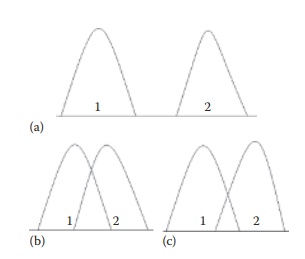
Figure 5.7 Three scenarios that may be encountered when comparing data sets from two samples, 1 and 2. In case A, the sample values of the two samples are significantly different by a large numeric value, indicating that the samples most likely represent two different populations. In case B, the sample values are so close to each other that it is very likely that both samples came from the same population and are not different from each other. In case C, the differences in sample values are intermediate. In the case of scenario C, it is difficult to make an assessment whether the two samples are really different from each other. In such cases, the tests of significance provide a statistical basis for decision making.
Parametric and nonparametric tests
A
sample or a population can be described by the mean and variance of all
observations, which represent statistical parameters, with an assumption of a
known underlying population distribution. Alternatively, a nonparametric
measure, such as median, can be used, which assume an underlying popula-tion
distribution but not necessarily a known distribution.
Accordingly,
statistical tests of significance can be parametric or nonparametric:
·
Parametric tests of significance are based on parametric
measures of distribution of data, viz., mean and variance of the data set. They
assume a specific and known distribution of the underlying population.
·
Nonparametric tests of significance are based on
nonparametric descriptors of distribution of data, viz., median and ranks of
the data values. They do not make the assumption about that the underlying
distribution of the population is known.
Parametric
tests are more powerful (less probability of type II error, described later)
than the nonparametric tests, since they use more information about the
samples. They are frequently used to provide information, such as inter-action
between two variables in a factorial design of experiments. However, they are
also more sensitive to skewness in the distribution of data and the presence of
outliers in the samples. Therefore, nonparametric tests may be preferred for
skewed distributions.
Parametric
tests are exemplified by t-test, chi square test, and analysis of variance
(ANOVA). Nonparametric tests are exemplified by Wilcoxon, Kruskal– Wallis, and
Mann– Whitney tests. The parametric tests will be described in more detail in
the following sections.
Null and alternate hypothesis
Statistical
tests of significance are designed to answer this and similar ques-tions with a
given level of confidence and power, expressed in numerical terms. Statistical
tests of significance can be used, for example, to test the hypothesis that (a)
a sampled data set comes from a single population or that (b) two sampled data
sets come from a single population. A statistical hypothesis represents an
assumption about a population parameter. This assumption may or may not be true
and is sought to be tested using the sta-tistical parameters obtained from a
sample. For example, if the statistical tests of significance test the
hypothesis that a given variation within or among data sets occurred purely by
chance, it would be termed the null hypothesis. In this case, therefore, the
null hypothesis is the hypothesis of no
difference. If the null hypothesis cannot be proven at the selected levels of
confidence and power of the test, the alternate
hypothesis is assumed to hold true. The alternate hypothesis indicates that
the sample observations are influenced by some nonrandom cause.
Steps of hypothesis testing
The
process of testing a hypothesis involves the following general steps:
1.
Ask the question (for a practical situation) that can be
addressed using one of the statistical tests of significance.
2.
Select the appropriate test of significance to be used and
verify the validity of underlying assumptions.
3.
State null and alternate hypothesis.
4.
Define significance level (e.g., α = 0.01, 0.05, or 0.1, which
indicates 1%, 5%, or 10% probability of occurrence of given differences just by
chance). Lower the significance level, greater the chance of not detecting the
differences when they actually do exist.
5.
Define sample size. Sample size affects the power of the
significance test. Higher the sample size, higher the power, that is, greater
the chance of detecting the differences when they actually do exist.
6.
Compute the test statistic.
7.
Identify the probability (p) of obtaining a test statistic as extreme as the calculated test
statistic for the calculated degrees of freedom, using standard probability
distribution tables.
8.
Compare this probability with the level of significance
desired. If psample at α < p, null hypothesis is rejected. If psample at α ≥ p, null hypothesis cannot be rejected.
One-tailed and two-tailed hypothesis tests
The
null and alternate hypotheses can be stated such that the null hypoth-esis is
rejected when the test statistic is higher or lower than a given value, or
both. The first two are called one-tailed hypothesis, while the latter is
termed two-tailed hypothesis. For example, if μ1 and μ2 represent the means
of two populations and H0 represents the null hypothesis, (H0:
μ1 − μ2 ≥ d) or (H0: μ1 − μ2 ≤ d) would be one-tailed hypothesis,
since H0 would be rejected when (μ1 − μ2 < d) and (μ1 − μ2 > d),
respectively. However, (H0: μ1 − μ2 = d) is a
two-tailed hypothesis, since the null hypothesis would be rejected in both
cases of (μ1 − μ2 < d) and (μ1 − μ2 > d).
The
appropriate statement of null hypothesis depends on the practical situation
being addressed. For example,
·
If a sample of tablets were collected during a production
run of tablet-ing unit operation and tested for average tablet weight, the
question could be asked whether the average tablet weight is the target tab-let
weight. In this case: (H0: Weightsample − Weighttarget
= 0) or (H0: Weightsample = Weighttarget)
would be a two-tailed hypothesis test, since the null hypothesis would be
rejected when the sample weight is both higher than or lower than the target
weight.
·
If a sample of tablets were collected during a production run
of the coating unit operation and tested for coating weight build-up on the
tablets, the question could be asked whether the coating weight build-up has
reached the target weight build-up of 3% w/w. In this case: (H0:
Weightsample – Weighttarget ≥ 0) would be a one-tailed
hypothesis test, since the null hypothesis would be rejected only if the sample
weight is less than the target weight.
Regions of acceptance and rejection
The
regions of acceptance and rejection of a hypothesis refer to regions in the
probability distribution of the sample’s test statistic. Assuming that the null
hypothesis is true, a sample’s test statistic is normally distributed, with the
shape of the distribution defined by the degrees of freedom of the sample.
Therefore, the probability of finding a given value of the test statistic can
be defined by this distribution curve. For example, Figure
5.8a shows the nor-mal distribution of a test statistic, with a vertical
line to the right indicating the value of the test statistic associated with a
probability of occurrence (α)
of 0.05, or 5%, by random chance, or Pα. Decreasing the
level of signifi-cance (α)
increases the rigor of the test; that is, the differences must be really
significant to be detected.
For
a one-tailed hypothesis test (Figure 5.8a), the
region of rejection lies on one (right) side of this distribution. If the test
statistic value obtained for the sample in question is higher than Pα , the test statistic in the sample
is assumed to lie in the region of rejection and the null hypothesis is
rejected at the chosen level of significance (α). Region of acceptance in this case
is defined as (−∞ to Pα).
For
a two-tailed hypothesis test (Figure 5.8b), the
region of rejection lies on either side of the distribution. If the test
statistic value obtained for the sample in question is higher than Pα or lower than −Pα , the test
statistic in the sample is assumed to lie in the region of rejection and the
null hypoth-esis is rejected at the chosen level of significance (α). Region of acceptance in this case
is defined as (−Pα to Pα).
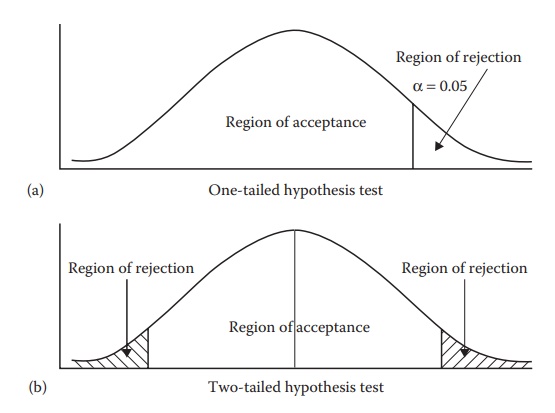
Figure 5.8 An illustration of regions of
acceptance and rejection in a normal probability distribution. Knowing the
probability of occurrence of sample values at either extremes from the mean as
a function of the standard deviation (Figure 5.6),
a given level of significance (e.g., α = 0.05) can quantify a cut-off point, indicated by a vertical line in the
plot. This vertical line in Figure 5.8a
represents 5% chance of occurrence of data values. Therefore, any value higher than
the indicated α line has a lower than 5% chance of occurrence and is said to fail in the region of rejection.
This is one-tailed hypothesis, since data values on only one side of the mean
are being considered for hypothesis testing. This side could be the positive
side, as indicated in Figure 5.8a, or the
negative side, which would be indicated by the α line on the left of the mean.
In a two-tailed hypothesis testing (Figure 5.8b),
data values on both positive and negative sides of the mean are considered.
Data values that are more extreme than the α line are said to fall in the
region of rejection. All other data values are considered in the region of
acceptance.
Probability value and power of a test
The
level of significance of test results is indicated by the probability value
(abbreviated as p-value). The p-value is the fractional probability of
accepting the null hypothesis, assuming that the null hypothesis is true. In
other words, lower the p-value of the
test, expressed as fractional prob-ability (e.g., 0.01, 0.05, or 0.1,
representing 1%, 5%, or 10% probability, respectively), greater the chance of
accepting the null hypothesis and not detecting differences between two
samples. Lower p-value indicates
greater difference between two samples. The commonly used probability level for
accepting the null hypothesis is 5%, corresponding to the p-value of 0.05.
The
power of a test of significance is the probability of rejecting the null hypothesis,
assuming that the null hypothesis is not true. In other words, higher the power
of the test, expressed in %, greater the chance that true differences between
two different sample sets would be detected. Power of a test can be increased
by increasing the sample size. The commonly accepted power of a test is 80%.
Types of error
Conducting
a test of significance can result in two types of errors in assessing the
difference in the chosen test statistic:
·
Type I error is a false positive in finding the difference
and inappro-priately rejected null hypothesis. This is the error of rejecting a
null hypothesis when it is actually true. In other words, type I error is the
error of finding the difference between the two samples when they are actually
not different. The probability of type I error is denoted by α.
The
probability of type I error is higher when the chosen level of significance, α, is higher. Therefore, using lower α tends to reduce the probability of
a type I error.
·
Type II error is a false negative in finding the difference
and inappro-priately failing to reject null hypothesis. This is the error of
not reject-ing a null hypothesis when it is actually not true. In other words,
type II error is the error of not finding difference between the two samples
when they are actually different. The probability of type II error is denoted
by β.
The
probability of type II error is higher when the chosen power of the test, β, is lower. Therefore, using higher β tends to reduce the probability of
a type II error.
Questions addressed by tests of significance
Tests
of significance are designed to answer specific types of questions based on a
selected test statistic and a probability distribution of the test statistic.
For example, the differences between means are tested using t-test, the
dif-ferences between proportions are tested using z-test, and the differences
in the frequency of a categorical variable are tested using χ2 test. Commonly used
tests of significance, an example situation, underlying assumptions of tests,
statement of null hypothesis, and calculations of the test statistic are
summarized in Table 5.6.
Table 5.6 Statistical tests of significance
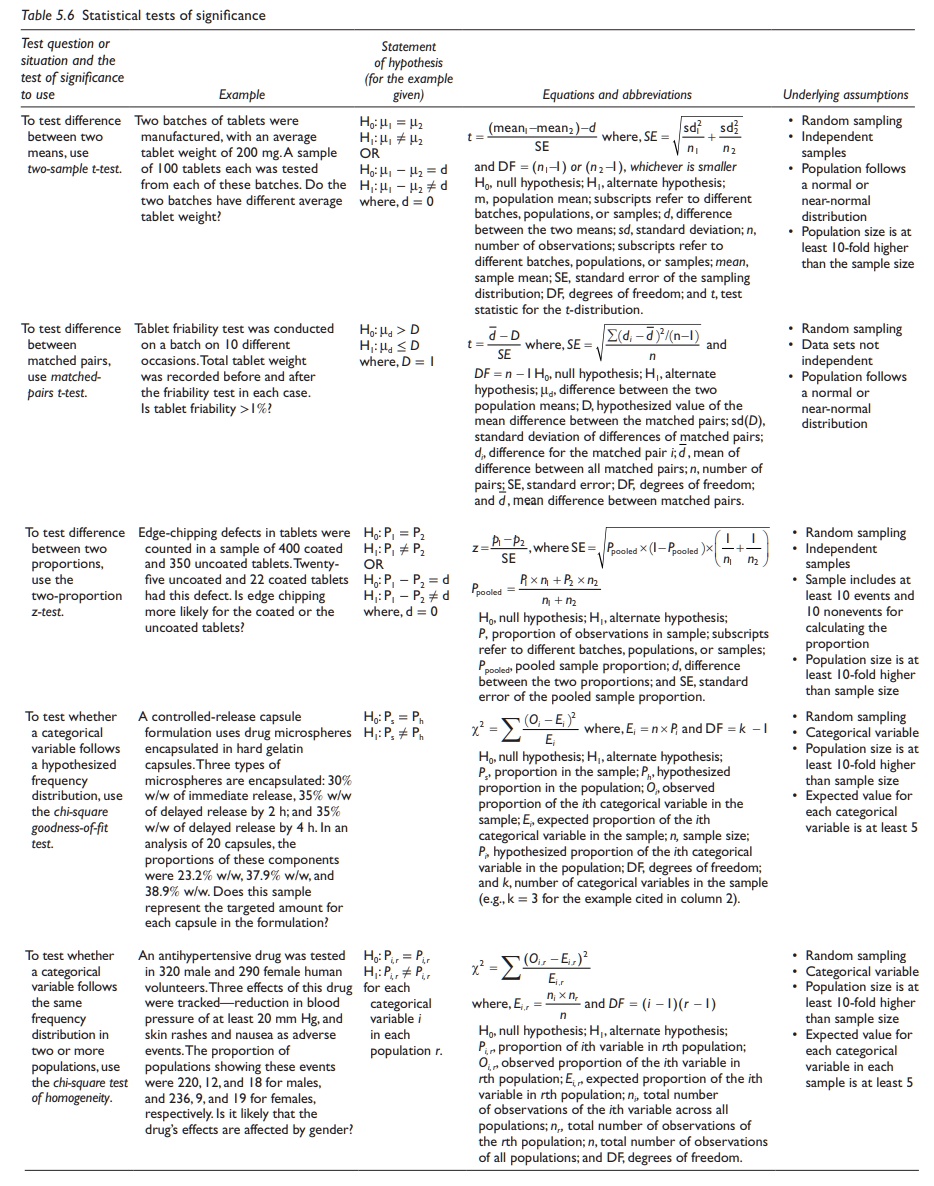
It
should be noted that these tests of significance invariably involve:
· The calculation of a test statistic, which represents the difference between the expected and the observed values, or the values of two samples. It also takes into account the variability in the sample through incorporation of standard error. The calculation of test statistic involves quantifying the extent of observed differences vis-à-vis the variability.
·
Identifying the probability value associated with the test
statistic at a given level of significance (Pα) for the given
degrees of freedom. The degree of freedom is calculated based on the sample
size and sometimes also the number of variables studied. The degrees of freedom
affect the distribution plot of the test statistic and thus the Pα value for a given α.
Having
calculated the Pα value and the test
statistic, the given test of signifi-cance is carried out per the steps
outlined earlier. For example, if the value of test statistic obtained for a
given test of significance is 0.942 and the Pα value at the
desired probability of error of 5% is 1.347, the test statistic falls in the
region of acceptance. Hence, the null hypothesis cannot be rejected. On the
other hand, if the test statistic value were higher than 1.347, the test
statistic would fall in the region of rejection. Hence, the null hypothesis
would be rejected.
Analysis of variance
The
analysis of variance uses differences between means and variances to quantify
statistical significance between means of different samples. Any number of
samples or subgroups may be compared in an ANOVA experiment. ANOVA is based on
the underlying explanation of variation of sample values from the population
mean as being a linear combination of the variable effect and random error.
The
number of variables (also termed treatments or factors) in an ANOVA experiment
can be one (one-way ANOVA), two (two-way ANOVA), or more. Each variable or
factor can be studied at different levels,
indicating the intensity. For example, a clinical study that evaluates one dose
of an experimental drug is a one-variable one-level experiment. A study that
eval-uates two doses of an experimental drug would be a one-variable two-level
study. Another study that evaluates three doses of two experimental drugs would
be a two-variable three-level study. The level may be a quantitative number,
such as the dose in the above examples, or it may be a numerical designation of
the presence or intensity of an effect, such as “0” and “1.”
1. One-way ANOVA
Model equation
When
sample sets are treated with a single variable at i different levels (i =
1, 2, 3, …, k), the value of each
data point is explained as:
yij = µ + τi + εij
where:
yij represents the jth observation of the ith level of treatment of the variable
μ is the mean of all samples in the experiment
τi is the ith treatment effect
εij represents random error
Hence,
the value of each data point in an experiment is represented in terms of the
mean of all samples and deviations arising from the effect of treat-ment or
variable being studied (τi) and random
variation (εij). This equation
represents a one-way ANOVA model.
Underlying assumptions
ANOVA
is used to test hypotheses regarding means of two or more samples, assuming the
following:
·
The underlying populations are normally distributed.
·
Variances of the underlying populations are approximately
equal.
·
The errors (εij) are random and
have a normal and independent distri-bution, with a mean of zero and a variance
of σ2ε .
Fixed- and random-effects model
The
one-way ANOVA model quantifies variation in each data point (yij) from the mean of all
data points (μ) as a combination
of random variation (εij) and the effect of
a known variable or treatment (τ).
Different subgroups of the experimental data points can be subjected to
different levels of the treatment, τi, where i = 1, 2, 3, … k. If the levels of the treatment are fixed, the model is termed fixed-effects model. On the other hand,
if the levels of the treatment are randomly assigned from several possible
levels, the model is termed random-effects
model.
Whether
the levels of a variable or treatment are fixed or random depends on the design
of the experiment. A fixed effects model is exemplified by three subgroups of a
group of 18 volunteers chosen for a pharmacokinetic study of a given drug at
dose levels of 0, 50, and 100 mg. A random effects model would be exemplified
by three subgroups of a group of 18 volunteers chosen for a pharmacokinetic
study of three different drugs A, B, and C at unknown and variable dose levels
(e.g., dose titration by the physician for individualization to the patient).
The effects are assumed to be random in the latter case, since the level of the
drug is not fixed.
The
selection of a study design as a fixed- or random-effects model is criti-cal to
the accuracy of data interpretation. The calculation of variance between
treatment groups is different between fixed- and random-effects model.
Null and alternate hypothesis
The
null hypothesis (H0) for a one-way ANOVA experiment would be no
difference between the population means of samples treated with different
levels of the selected factor. The alternate hypothesis (H1) states
that the means of underlying populations are not equal.
Calculations for fixed-effects model from first principles
ANOVA
is based on the calculation of ratio of variance introduced by the factor and
random variations. Although many software tools are currently available that
reduce the requirement for tedious calculations, it is impor-tant to understand
the calculations of statistical tests of significance from first principles.
1.
Mean of all samples in the experiment (μ) is calculated by adding all
observations and dividing by the total number of samples in the experiment.

where,
yij represents the jth observation of the ith level of treatment of the variable,
there being a total of k treatments (i = 1, 2, 3, … k) and n samples per treatment
level (j = 1, 2, 3, …. n), and N
being the total n sample size,
including all treatments and levels.
2.
Total sum of squares (SST) of all observations is calculated by
squaring all observations and subtracting from the mean of all samples in the
experiment (μ).

3.
Sum of squares for the factor studied is the sum of squares between the columns
(SSbetween) if each level of the factor is arranged in a col-umn. It
is calculated by subtracting the mean value for each column from the mean of
all samples, squaring this value, and adding for all columns.
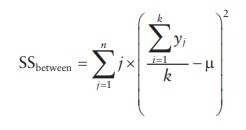
4. Sum of squares for the random error (SSerror)
is the difference between the total sum of squares and the sum of squares
between and within the columns.
SSerror
= SStotal − SSbetween
5.
Degrees of freedom are calculated as follows:
Degrees
of freedom between groups (DFbetween):
DFbetween
= k − 1
Degrees
of freedom for the error term (DFerror):
DFerror
= N − k
6.
Mean squares for the random error (MSerror) and the factor studied
(MSbetween) are calculated by dividing their respective sum of
squares by their DF.
MSbetween
= SSbetween /DFbetween
MSerror
= SSerror/DFerror
7.
An F-ratio is computed as the ratio of mean squares of factor effect to the
mean square of error effect.
F = MSbetween / MSerror
8. Determine critical F-ratio at (DFbetween and
DFerror) degrees of freedom for α = 0.05.
9.
Test the hypothesis. The F-ratio is compared to the Pα value for the
F-test at designated degrees of freedom to determine the signifi-cance of
observed results. Statistical significance of results would indicate that the
contribution of the factor’s or variable’s effect on the observations is
significantly greater than the variation that can be ascribed to random error.
Example of calculations for fixed-effects model
The
computation of statistical significance by one-way ANOVA can be illus-trated by
a case of administration of two doses of a test antihyperlipidemic compound and
a placebo to a set of six patients in each group. Hypothetical results of this
study in terms of reduction of blood cholesterol level are
Table 5.7 A hypothetical example of a
one-way ANOVA experiment
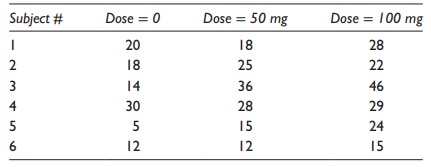
Table 5.8 Rephrasing the data in
statistical terms for a hypothetical example of a one-way ANOVA experiment
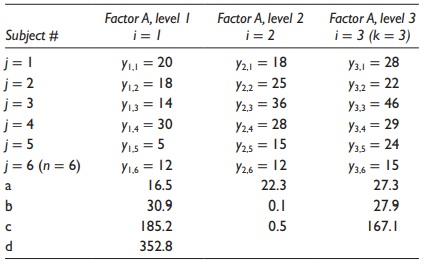
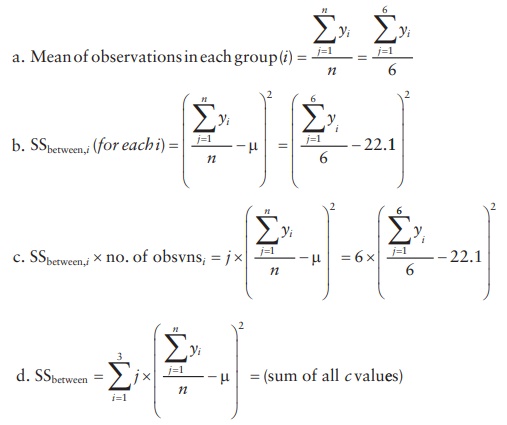
1.
Mean of all samples in the experiment (μ):

2. Total sum of squares of variation in all data points (SST):
The calculations are illustrated in Table 5.9.
Squaring
(yij-μ) values and adding them together,

3. Sum of squares of variation coming from the factor
studied (SSbetween): As calculated in Table
5.8.
4. Sum of squares of variation coming from random error (SSerror):
As calculated in Table 5.8.
SStotal
= Sbetween
+ SSerror
SSerror
= SStotal − SSbetween
SSerror
= 1656.9 − 352.8 = 1304.2
5. Degrees of freedom (DF):
Degrees
of freedom between groups (DFbetween):
DFbetween
= k − 1 = 3 − 1 = 2
Table 5.9 Calculations for a hypothetical
example of a one-way ANOVA experiment

Degrees
of freedom for the error term (DFerror):
DFerror
= N − k
= 18 − 3 = 15
6. Mean squares (MS) of variation:
Mean
square between groups (MSbetween):
MSbetween
= SSbetween
/ DFbetween =
352.8/2 = 176.4
Mean
square for the error term (MSerror):
MSerror
= SSerror/
DFerror = 1304.2/15 = 86.9
7.
F-ratio:
F = MSbetween / MSerror = 176.4/86.9 = 2 .0
8. Determine the critical F-ratio at the chosen Pα value. Determine the critical
F-ratio at (2, 15) degrees of freedom for α = 0.05 is 3.7.
9.
Test the hypothesis: Since the obtained F-value is lower than the criti-cal
F-value, the null hypothesis (no difference) cannot be rejected. In this
example, although the data do look significantly different when reviewed
without statistical analysis, the high random error in the observations leads
to lack of statistical significance.
An
alternate means to test the hypothesis is to use the standard tables to
determine the p-value associated with
the observed F-value. If the observed p-value
is less than the chosen Pα value (e.g., 0.05), the null hypothesis is rejected. For example, in the above
calculations, the p-value associated
with the observed F-ratio is 0.17. Since this is higher than 0.05, the null
hypothesis cannot be rejected.
Calculations using Microsoft Excel
An
alternate to calculations from first principles is to use one of the available
software tools for calculations. As an illustration, when Microsoft Excel’s
data analysis add-in function is utilized for single-factor ANOVA
calcula-tions, the software provides a tabular output of calculated values
illustrated in Table 5.10.
This
tabular output of results summarizes statistical parameters associ-ated with
the data, followed by a summary of calculated results in a tabular format. The
critical F-value and the p-value
associated with the calculated F-value are indicated to facilitate hypothesis
testing.
Table 5.10 Statistical results for a
hypothetical example of a one-way ANOVA experiment using Microsoft Excel
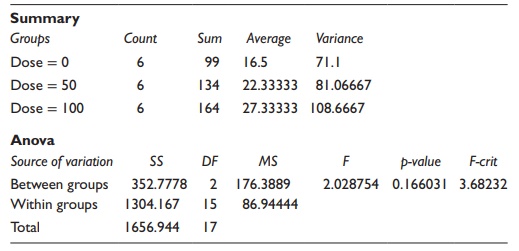
2. Two-way ANOVA: Design of experiments
Two-way
ANOVA deals with investigation of effects of two variables in a set of
experiments. ANOVA with two or more variables (also called treat-ments or
factors) is most commonly utilized in the design of experiments.
Factorial experiments
When
the effects of more than one factor are studied at one or more levels, the
factorial experiment is defined as an LF-factorial experiment. For
exam-ple, three factors evaluated at two different levels would be a 23
factorial experiment and two factors evaluated at three different levels would
be a 32 experiment. An example of such studies is the effect of
temperature and pres-sure on the progress of a reaction. If an experiment is
run at two temperature and pressure values, it is a 22 factorial experiment,
with the total number of runs = 2 × 2 = 4. If the experiment were run at three
levels of temperature and pressure, it would be a 32 factorial
experiment, with the total number of experimental runs = 3 × 3 = 9. Conversely,
if three factors (e.g., tempera-ture, pressure, and reactant concentration)
were studied at two levels each, it would be a 23 factorial
experiment, with 2 × 2 2 = 8 experimental runs. The experiments could be
full-factorial or partial-factorial.
·
A full-factorial experiment is one in which all combinations
of all fac-tors and levels are studied. For example, a full-factorial
four-factor, two-level study would involve 24 = 2 × 2 × 2 × 2 = 16
experimental runs. Full-factorial experiments provide information on both the
main effects of various factors and the effects of their interactions. Design
and interpretation of a two-factor, two-level experiment are illustrated in the
two-way ANOVA model.
·
A partial-factorial experiment is one in which half the
combinations of levels of all factors are studied. For example, a
partial-factorial four-factor, two-level study would involve 24−1 =
16/2 = 8 experi-mental runs. Partial-factorial experiments provide information
on the main effects of various factors but not on the interaction effects. Design
and interpretation of partial-factorial experiments are beyond the scope of
this chapter.
Model equation
If
there are two variables or treatments being studied in the experiment, the
value of each data point is explained as:
yijk = µ + τi + β j + γij + εijk
where:
yijk represents the jth observation of the ith level of treatment of the first variable and kth treatment of the second variable
μ is the mean of all samples in the experiment
τi is the ith treatment effect
of the first variable
βj is the jth treatment effect
of the second variable
εijk represents random error
Hence,
the value of each data point in an experiment is represented in terms of the
mean of all samples and deviations arising from the effect of treat-ment or
variable being studied (τi) and random
variation (εij). Hence, the value
of each data point in an experiment is represented in terms of the mean of all
samples and deviations arising from the effect of two treat-ments or variables
being studied (individual or main effects, τi and βj and effects arising
from interaction of these variables, γij) and random
variation (εij). The variables in
this experiment are commonly termed factors,
and the experiment is termed a factorial
experiment. This equation represents a two-way
ANOVA model.
Null and alternate hypotheses
The
null hypotheses (H0) for a two-way ANOVA experiment studying factors
A and B could be the following:
·
No difference between the population means of samples
treated with different levels of factor A. The alternate hypothesis (H1)
would be that the means of underlying populations are not equal.
·
No difference between the population means of samples
treated with different levels of factor B. The alternate hypothesis (H1)
would be that the means of underlying populations are not equal.
·
No difference between the population means of samples
treated with different combinations of different levels of factors A and B (For
example, if both factors A and B had two levels - high and low - the
combinations could be high [A] with low [B] versus low [A] with high [B]. A
study of this interaction reveals whether the effect of factor A is different
when factor B is low versus high or not.). The alternate hypoth-esis (H1)
would be that there is an interaction between factors A and B.
Calculations
The
calculations for a two-way ANOVA experiment are similar to the one-way ANOVA,
with the inclusion of the case of a second variable B at levels 1 through b.
The equations for the one-way ANOVA in the corre-sponding previous section are
considered as the effect of variable A. The equations are modified as below for
inclusion of the effect of variable B.
1.
Mean of all samples in the experiment (μ) is calculated by adding all
observations and dividing by the total number of samples in the experiment.
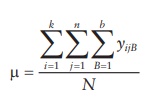
where,
yijk represents the jth observation of the ith level of treatment of the variable A
and bth level of treatment of
variable B, there being a total of k
treatments (i = 1, 2, 3, … k) and n samples per treatment level (j
= 1, 2, 3, …. n) for variable A and b treatments (B = 1, 2, 3, … b) and n samples per treatment level (j =
1, 2, 3, …. n) for variable B; N
is the total sample size, including all treatments and levels.
2.
Total sum of squares (SST) of all observations is calculated by
squar-ing all observations and subtracting from the mean of all samples in the
experiment (μ).

3.
Sum of squares for the factor is the sum of squares between the col-umns (SSbetween)
if each level of the factor is arranged in a column. It is calculated by
subtracting the mean value for each column from the mean of all samples,
squaring this value, and adding for all columns.
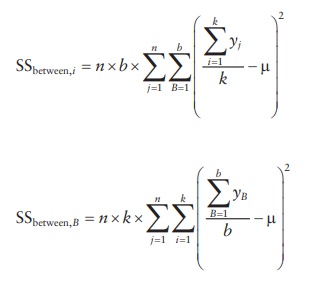
Sum
of squares for interaction between factors A and B is determined by:

4. Sum of squares for the random error (SSerror)
is the difference between the total sum of squares and the sum of squares
between and within the columns.
SSerror
= SStotal − SSbetween,i −
SSbetween,B
5.
Degrees of freedom are calculated as follows:
Degrees
of freedom between groups (DFbetween):
DFbetween,i = k
− 1
DFbetween,B = b
− 1
Degrees
of freedom for the error term (DFerror):
DFerror
= N − k
× b
Degrees
of freedom for the interaction term (DFinteraction):
DFinteraction
= (k − 1)(b − 1)
6.
Mean squares for the random error (MSerror) and the factor studied
(MSbetween) are calculated by dividing their respective sum of
squares by their degrees of freedom.
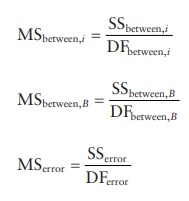
7.
An F-ratio is computed as the ratio of mean squares of factor effect to the
mean square of error effect.
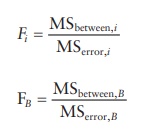
8.
Determine critical F-ratio at (DFbetween and DFerror)
degrees of freedom for α
= 0.05.
9.
Test the hypothesis: The F-ratio is compared to the Pα value for the
F-test at designated degrees of freedom to determine the significance of
observed results. Statistical significance of results would indicate that the
contribution of the factor’s or variable’s effect on the observa-tions is
significantly greater than the variation that can be ascribed to random error.
Calculations using Microsoft Excel
As
an illustration of two-way ANOVA calculations using Microsoft Excel’s data
analysis add-in tool, the example summarized in Table
5.11 provides a tabular output of calculated values listed in Table 5.12.
Table 5.11 A hypothetical example of a
two-way ANOVA experiment. Yield of a chemical synthesis reaction was studied as
a function of temperature and pressure in a 22 full-factorial study
without replication. The data, in terms of percentage yield, are summarized in
the table

Table 5.12 Statistical results for a
hypothetical example of a two-way ANOVA experiment using Microsoft Excel
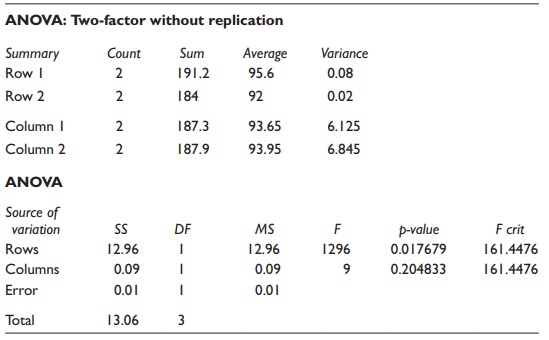
This tabular output of results summarizes statistical parameters asso-ciated with the data, followed by a summary of calculated results in a tabular format. The critical F-value and the p-value associated with the calculated F-value are indicated to facilitate hypothesis testing. Two-way ANOVA results provide information about statistical significance of differ-ences attributable to both factors. Thus, in this example, the contribution of columns (pressure) to variation has a p-value of 0.20, while the contribu-tion of rows (temperature) has a p-value of 0.02. Given the α value of 0.05, the contribution of temperature is significant, while that of pressure is not.
Related Topics
